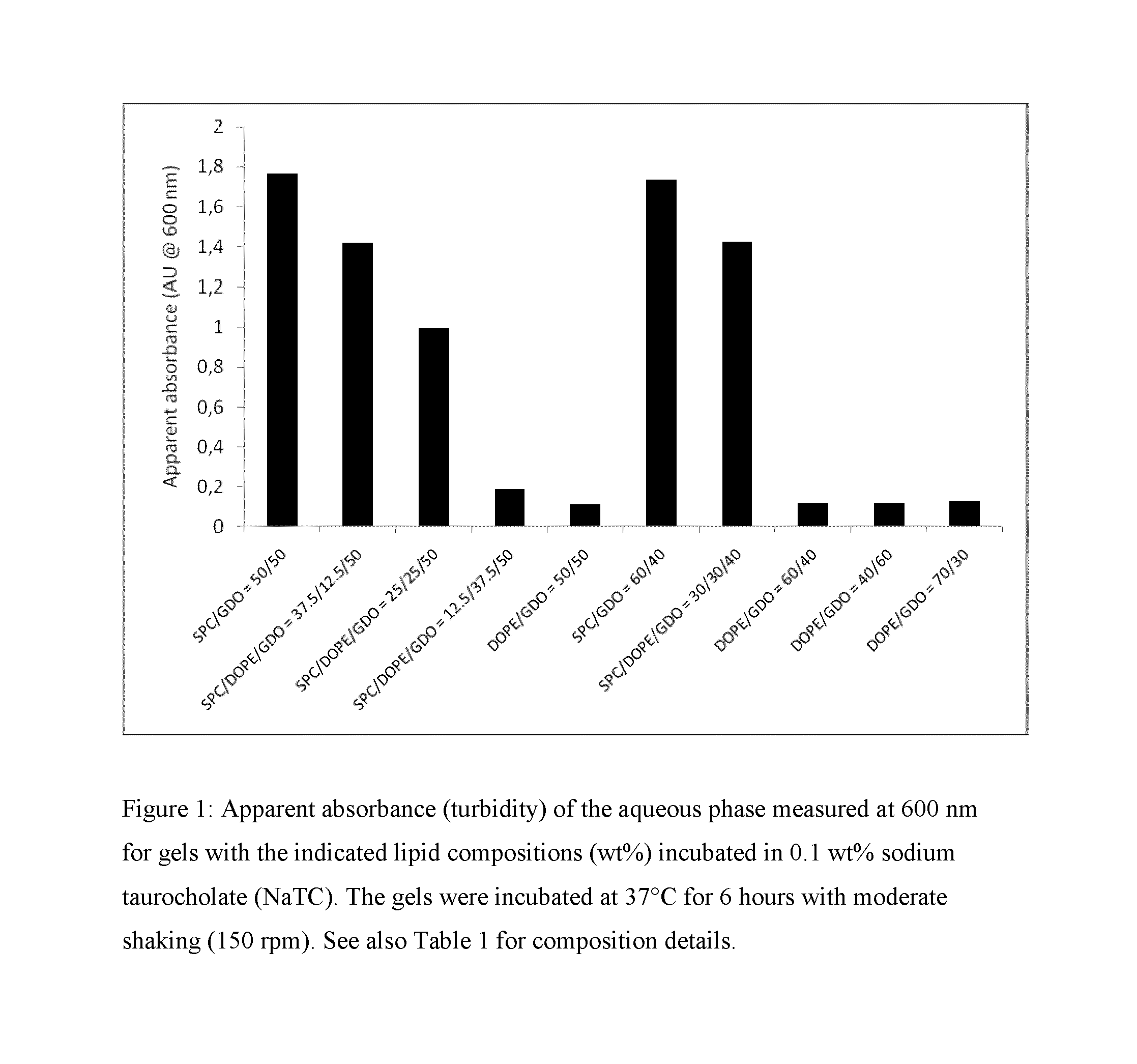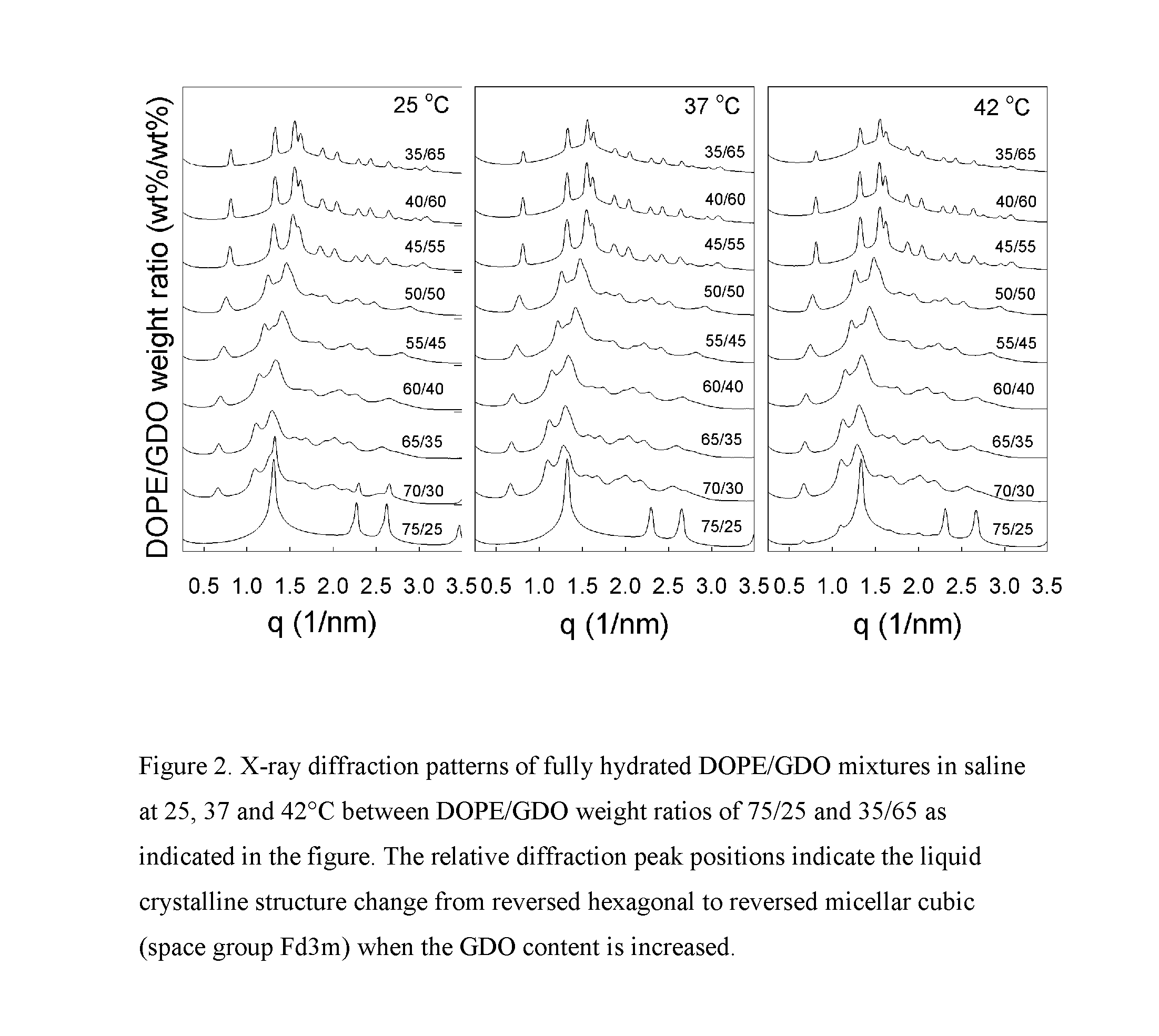Robust controlled-release peptide formulations
a technology of peptides and formulations, applied in the direction of peptide/protein ingredients, depsipeptides, liposomal delivery, etc., can solve the problem of insufficient formation of the liquid crystalline phase necessary to achieve the effect of crystalline phas
- Summary
- Abstract
- Description
- Claims
- Application Information
AI Technical Summary
Benefits of technology
Problems solved by technology
Method used
Image
Examples
example 1
Liquid Pre-Formulations Comprising Phospholipid and Diacylglycerol
[0216]Liquid pre-formulations (2 g) of phospholipid and diacylglycerol were prepared by weighing in the respective lipid and solvent components according to Table 1 in 3 mL (2R) vials followed by roller mixing at 40° C. until homogenous liquid solutions were obtained (<20 h). After cooling to room temperature, all formulations were observed to be homogenous liquids of low viscosity.
TABLE 1Composition of liquid pre-formulations comprising phospholipid and diacylglycerol (wt %)Formulation#SPCDOPEGDOEtOHLipid composition (wt %)145—4510SPC / GDO = 50 / 50233.511.54510SPC / DOPE / GDO = 37.5 / 12.5 / 50322.522.54510SPC / DOPE / GDO = 25 / 25 / 50411344510SPC / DOPE / GDO = 12.5 / 37.5 / 505—454510DOPE / GDO = 50 / 50652.8—35.212SPC / GDO = 60 / 40726.426.435.212SPC / DOPE / GDO = 30 / 30 / 408—52.835.212DOPE / GDO = 60 / 409—365410DOPE / GDO = 40 / 6010—59.525.515DOPE / GDO = 70 / 30
example 2
Gelling of Pre-Formulations in Phosphate-Buffered Saline (PBS)
[0217]All liquid pre-formulations in Table 1 were subjected to a gelling test whereby 0.20 g of the respective formulation was injected into 5 mL of PBS (pH 7.4) in 6 mL (6R) injection glass vials using disposable 1 mL Luer-Lock syringes and 23 G needles. All formulations were easily injected using the 23 G needle size. The resulting gels were inspected visually after 1 h at room temperature and found to form coherent gels that could not be disrupted by mild shaking of the vials.
example 3
Robustness of Lipid Gels in the Presence of Bile Salt
[0218]For long-term depot formulations and / or for per-oral formulations, a crucial property is related to the robustness of the gel towards erosion / fragmentation by endogenous surfactants and / or lipid-degrading enzymes. A way to study the robustness in vitro is to subject the lipid gels to a surfactant-rich aqueous environment and subsequently measure the increased turbidity (or apparent absorbance) of the aqueous phase resulting from surfactant-eroded lipid fragments. Such lipid fragments give rise to substantial increase in solution turbidity due to light scattering. Bile salts are often used as the surfactant of choice for studying formulation dissolution given their biological relevance and endogenous nature. Accordingly, gels (0.20 g) formed in PBS by the formulations given in Table 1 were placed in 5 mL of a 0.1 wt % sodium taurocholate (NaTC) solution in PBS. The resulting samples were thereafter transferred to an incubator...
PUM
| Property | Measurement | Unit |
|---|---|---|
| Temperature | aaaaa | aaaaa |
| Temperature | aaaaa | aaaaa |
| Fraction | aaaaa | aaaaa |
Abstract
Description
Claims
Application Information
 Login to View More
Login to View More - R&D
- Intellectual Property
- Life Sciences
- Materials
- Tech Scout
- Unparalleled Data Quality
- Higher Quality Content
- 60% Fewer Hallucinations
Browse by: Latest US Patents, China's latest patents, Technical Efficacy Thesaurus, Application Domain, Technology Topic, Popular Technical Reports.
© 2025 PatSnap. All rights reserved.Legal|Privacy policy|Modern Slavery Act Transparency Statement|Sitemap|About US| Contact US: help@patsnap.com



